| Listing 1 - 10 of 10 |
Sort by
|
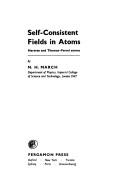
ISBN: 0080178197 0080178200 1322302049 1483278905 Year: 1975 Publisher: Oxford : Pergamon,
Abstract | Keywords | Export | Availability | Bookmark
 Loading...
Loading...Choose an application
- Reference Manager
- EndNote
- RefWorks (Direct export to RefWorks)
Atoms --- -Hartree-Fock approximation --- Self-consistent field theory --- SCF theory --- Self consistent field method --- Self consistent fields --- Field theory (Physics) --- Molecular orbitals --- Hartree approximation --- Hartree-Fock-Slater approximation --- Approximation theory --- Energy-band theory of solids --- Many-body problem --- Chemistry, Physical and theoretical --- Matter --- Stereochemistry --- Mathematical models --- Constitution --- Hartree-Fock approximation. --- Self-consistent field theory. --- Mathematical models. --- Hartree-Fock approximation
Book
ISBN: 0720403413 0444109625 Year: 1975 Publisher: Amsterdam London : New York, NY : North-Holland American Elsevier,
Abstract | Keywords | Export | Availability | Bookmark
 Loading...
Loading...Choose an application
- Reference Manager
- EndNote
- RefWorks (Direct export to RefWorks)
Hartree-Fock approximation --- -Nuclear shell theory --- -Self-consistent field theory --- -539.1 --- SCF theory --- Self consistent field method --- Self consistent fields --- Field theory (Physics) --- Molecular orbitals --- Nuclear shell models --- Nuclear shell structure --- Shell models (Nuclear physics) --- Nuclear models --- Hartree approximation --- Hartree-Fock-Slater approximation --- Approximation theory --- Atoms --- Energy-band theory of solids --- Many-body problem --- Self-consistent field theory --- Congresses --- Nuclear physics. Atomic physics. Molecular physics --- Nuclear physics. --- Nuclei --- Field theory (Physics). --- Self-consistent field theory. --- 539.1 Nuclear physics. Atomic physics. Molecular physics --- Nuclear shell theory --- 539.1
Book
ISBN: 047125990X Year: 1977 Publisher: London ; New York, NY : Wiley-Interscience,
Abstract | Keywords | Export | Availability | Bookmark
 Loading...
Loading...Choose an application
- Reference Manager
- EndNote
- RefWorks (Direct export to RefWorks)
Atomic physics --- 530.145 --- Atoms --- Hartree-Fock approximation --- Hartree approximation --- Hartree-Fock-Slater approximation --- Approximation theory --- Energy-band theory of solids --- Many-body problem --- Self-consistent field theory --- Chemistry, Physical and theoretical --- Matter --- Stereochemistry --- Quantum theory --- Constitution --- Atoms. --- Hartree-Fock approximation. --- 530.145 Quantum theory
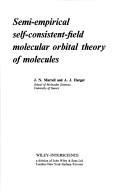
ISBN: 0471626805 9780471626800 Year: 1972 Publisher: New York, NY : John Wiley,
Abstract | Keywords | Export | Availability | Bookmark
 Loading...
Loading...Choose an application
- Reference Manager
- EndNote
- RefWorks (Direct export to RefWorks)
Physicochemistry --- fysicochemie --- Molecular orbitals --- Self-consistent field theory --- 539.194 --- SCF theory --- Self consistent field method --- Self consistent fields --- Field theory (Physics) --- Orbitals, Molecular --- Chemical bonds --- Electrons --- Molecules --- Overlap integral --- Quantum chemistry --- Valence (Theoretical chemistry) --- Wave mechanics --- Internal mechanics of molecules. Energy relationships. Vibration and rotation in molecules. Electronic levels. Bonds. Resonance energies, potentials. Nuclear coupling. Polarizability etc. --- Molecular orbitals. --- Self-consistent field theory. --- Basic Sciences. Chemistry --- Physical Chemistry --- Physical Chemistry. --- 539.194 Internal mechanics of molecules. Energy relationships. Vibration and rotation in molecules. Electronic levels. Bonds. Resonance energies, potentials. Nuclear coupling. Polarizability etc. --- Internal mechanics of molecules. Energy relationships. Vibration and rotation in molecules. Electronic levels. Bonds. Resonance energies, potentials. Nuclear coupling. Polarizability etc
Book
ISSN: 0933033X ISBN: 1280461098 9786610461097 3540312978 Year: 2006 Volume: 84 Publisher: Berlin ; New York : Springer,
Abstract | Keywords | Export | Availability | Bookmark
 Loading...
Loading...Choose an application
- Reference Manager
- EndNote
- RefWorks (Direct export to RefWorks)
Molecular-orbital calculations for materials design such as alloys, ceramics, and coordination compounds are now possible for experimentalists. Molecuar-orbital calculations for the interpretation of chemical effect of spectra are also possible for experimentalists. The most suitable molecular-orbital calculation method for these purpose is the DV-Xa method, which is robust in such a way that the calculation converges to a result even if the structure of the molecule or solid is impossible in the pressure and temperature ranges on earth. This book specially addresses the methods to design novel materials and to predict the spectrallline shape of unknown materials using the DV-Xa molecular-orbital method, but is also useful for those who want to calculate electronic structures of materials using any kind of method.
Hartree-Fock approximation. --- Approximation theory. --- Materials. --- Engineering. --- Condensed Matter Physics. --- Materials Science, general. --- Engineering, general. --- Theory of approximation --- Functional analysis --- Functions --- Polynomials --- Chebyshev systems --- Hartree approximation --- Hartree-Fock-Slater approximation --- Approximation theory --- Atoms --- Energy-band theory of solids --- Many-body problem --- Self-consistent field theory --- Construction --- Industrial arts --- Technology --- Engineering --- Engineering materials --- Industrial materials --- Engineering design --- Manufacturing processes --- Materials --- Condensed matter. --- Materials science. --- Condensed materials --- Condensed media --- Condensed phase --- Materials, Condensed --- Media, Condensed --- Phase, Condensed --- Liquids --- Matter --- Solids --- Material science --- Physical sciences
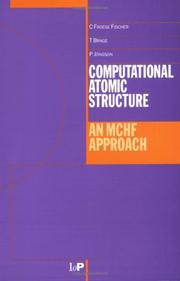
ISBN: 0750303743 0750304669 9780750303743 9780750304665 Year: 1997 Publisher: Bristol, UK : Institute of Physics Publishing,
Abstract | Keywords | Export | Availability | Bookmark
 Loading...
Loading...Choose an application
- Reference Manager
- EndNote
- RefWorks (Direct export to RefWorks)
Atomic structure --- Hartree-Fock approximation. --- Méthode d'approximation Hartree-Fock --- Measurement --- Data processing. --- Méthode d'approximation Hartree-Fock --- Hartree-Fock approximation --- 539.182 --- 539.182 General theory. Wave functions. Methods of solution. Atomic models --- General theory. Wave functions. Methods of solution. Atomic models --- Hartree approximation --- Hartree-Fock-Slater approximation --- Approximation theory --- Atoms --- Energy-band theory of solids --- Many-body problem --- Self-consistent field theory --- Measurement&delete& --- Data processing --- Structure, Atomic --- Atomic theory
Book
ISBN: 0444414614 Year: 1976 Publisher: Amsterdam Oxford New York : Elsevier Scientific Pub. Co.,
Abstract | Keywords | Export | Availability | Bookmark
 Loading...
Loading...Choose an application
- Reference Manager
- EndNote
- RefWorks (Direct export to RefWorks)
Atomic physics --- Hartree-Fock approximation --- Atomes --- -Hartree-Fock approximation --- -Ions --- -Intermediates (Chemistry) --- Electrolysis --- Hartree approximation --- Hartree-Fock-Slater approximation --- Self-consistent field theory --- -Physics of single atoms --- -539.18 Physics of single atoms --- Atoms --- Ions --- 539.18 --- 539.18 Physics of single atoms --- Physics of single atoms --- Approximation theory --- Energy-band theory of solids --- Many-body problem --- Chemistry, Physical and theoretical --- Matter --- Stereochemistry --- Intermediates (Chemistry) --- Physics --- Solution (Chemistry) --- Electrons --- Handbooks, manuals, etc --- Constitution --- Properties --- Handbooks, manuals, etc. --- Guides, manuels, etc
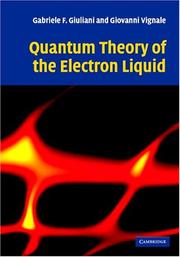
ISBN: 9780511619915 9780521821124 9780521527965 051161991X 9780511410260 0511410263 0521821126 0521821126 0521527961 1107174457 1281717398 9786611717391 0511409729 0511408390 0511407629 0511409206 Year: 2005 Publisher: Cambridge Cambridge University Press
Abstract | Keywords | Export | Availability | Bookmark
 Loading...
Loading...Choose an application
- Reference Manager
- EndNote
- RefWorks (Direct export to RefWorks)
Modern electronic devices and novel materials often derive their extraordinary properties from the intriguing, complex behavior of large numbers of electrons forming what is known as an electron liquid. This book provides an in-depth introduction to the physics of the interacting electron liquid in a broad variety of systems, including metals, semiconductors, artificial nano-structures, atoms and molecules. One, two and three dimensional systems are treated separately and in parallel. Different phases of the electron liquid, from the Landau Fermi liquid to the Wigner crystal, from the Luttinger liquid to the quantum Hall liquid are extensively discussed. Both static and time-dependent density functional theory are presented in detail. Although the emphasis is on the development of the basic physical ideas and on a critical discussion of the most useful approximations, the formal derivation of the results is highly detailed and based on the simplest, most direct methods.
Fermi liquid theory --- Fermi surfaces --- Hartree-Fock approximation --- Many-body problem --- Quantum field theory --- Relativistic quantum field theory --- Field theory (Physics) --- Quantum theory --- Relativity (Physics) --- n-body problem --- Problem of many bodies --- Problem of n-bodies --- Mechanics, Analytic --- Hartree approximation --- Hartree-Fock-Slater approximation --- Approximation theory --- Atoms --- Energy-band theory of solids --- Self-consistent field theory --- Surfaces, Fermi --- Electrons --- Free electron theory of metals --- Quantum statistics --- Landau Fermi liquid theory --- Landau theory of Fermi liquids --- Landau's theory of Fermi liquids --- Fermi liquids
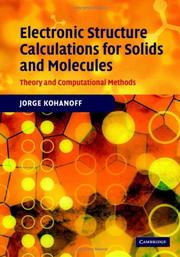
ISBN: 9780521815918 0521815916 9780511755613 9780511648311 0511648316 0511190875 9780511190872 0511190557 9780511190551 0511189915 9780511189913 0511755619 051156175X 9780511561757 1107159229 Year: 2006 Publisher: Cambridge Cambridge University Press
Abstract | Keywords | Export | Availability | Bookmark
 Loading...
Loading...Choose an application
- Reference Manager
- EndNote
- RefWorks (Direct export to RefWorks)
Electronic structure problems are studied in condensed matter physics and theoretical chemistry to provide important insights into the properties of matter. This 2006 graduate textbook describes the main theoretical approaches and computational techniques, from the simplest approximations to the most sophisticated methods. It starts with a detailed description of the various theoretical approaches to calculating the electronic structure of solids and molecules, including density-functional theory and chemical methods based on Hartree-Fock theory. The basic approximations are thoroughly discussed, and an in-depth overview of recent advances and alternative approaches in DFT is given. The second part discusses the different practical methods used to solve the electronic structure problem computationally, for both DFT and Hartree-Fock approaches. Adopting a unique and open approach, this textbook is aimed at graduate students in physics and chemistry, and is intended to improve communication between these communities. It also serves as a reference for researchers entering the field.
Density functionals. --- Hartree-Fock approximation. --- Condensed matter --- Fonctionnelles densité --- Méthode d'approximation Hartree-Fock --- Matière condensée --- Computer simulation. --- Simulation par ordinateur --- Hartree-Fock approximation --- Density functionals --- Hartree-Fock, Méthode d'approximation --- Computer simulation --- Fonctionnelles densité --- Méthode d'approximation Hartree-Fock --- Matière condensée --- Hartree-Fock, Méthode d'approximation. --- Fonctionnelles densité. --- Simulation par ordinateur. --- Condensed materials --- Condensed media --- Condensed phase --- Materials, Condensed --- Media, Condensed --- Phase, Condensed --- Liquids --- Matter --- Solids --- Density functional methods --- Density functional theory --- Functional methods, Density --- Functionals, Density --- Functional analysis --- Hartree approximation --- Hartree-Fock-Slater approximation --- Approximation theory --- Atoms --- Energy-band theory of solids --- Many-body problem --- Self-consistent field theory
Book
ISBN: 9048176948 1281141593 1402069685 9786611141592 1402066643 1402066635 1402069677 Year: 2008 Publisher: Dordrecht : Springer Netherlands : Imprint: Springer,
Abstract | Keywords | Export | Availability | Bookmark
 Loading...
Loading...Choose an application
- Reference Manager
- EndNote
- RefWorks (Direct export to RefWorks)
The book is dedicated to the application of self-consistent methods to the solution of static and dynamic problems of the mechanics and physics of composite materials. The effective elastic, electric, dielectric, thermo-conductive and other properties of composite materials reinforced by ellipsoidal, spherical multi-layered inclusions, thin hard and soft inclusions, short fibers and unidirected multi-layered fibers are considered. Explicit formulas and efficient computational algorithms for the calculation of the effective properties of the composites are presented and analyzed. The method of the effective medium and the method of the effective field are developed for the calculation of the phase velocities and attenuation of the mean (coherent) wave fields propagating in the composites. The predictions of the methods are compared with experimental data and exact solutions for the composites with periodical microstructures. The book may be useful for material engineers creating new composite materials and scholars who work on the theory of composite and non-homogeneous media.
Self-consistent field theory. --- Inhomogeneous materials. --- Composite materials. --- Engineering mathematics. --- Composite materials --- Inhomogeneous materials --- Mechanical properties. --- Engineering --- Engineering analysis --- Mathematical analysis --- Composites (Materials) --- Multiphase materials --- Reinforced solids --- Solids, Reinforced --- Two phase materials --- Materials --- Heterogeneous materials --- Inhomogeneous media --- Media, Inhomogeneous --- Matter --- SCF theory --- Self consistent field method --- Self consistent fields --- Field theory (Physics) --- Molecular orbitals --- Mathematics --- Materials. --- Mechanics. --- Mechanics, Applied. --- Surfaces (Physics). --- Materials Science, general. --- Solid Mechanics. --- Structural Materials. --- Ceramics, Glass, Composites, Natural Materials. --- Characterization and Evaluation of Materials. --- Classical Electrodynamics. --- Physics --- Surface chemistry --- Surfaces (Technology) --- Applied mechanics --- Engineering, Mechanical --- Engineering mathematics --- Classical mechanics --- Newtonian mechanics --- Dynamics --- Quantum theory --- Engineering materials --- Industrial materials --- Engineering design --- Manufacturing processes --- Materials science. --- Structural materials. --- Ceramics. --- Glass. --- Composites (Materials). --- Optics. --- Electrodynamics. --- Light --- Amorphous substances --- Ceramics --- Glazing --- Ceramic technology --- Industrial ceramics --- Keramics --- Building materials --- Chemistry, Technical --- Clay --- Architectural materials --- Architecture --- Building --- Building supplies --- Buildings --- Construction materials --- Structural materials --- Material science --- Physical sciences
| Listing 1 - 10 of 10 |
Sort by
|

 Search
Search Feedback
Feedback About UniCat
About UniCat  Help
Help News
News